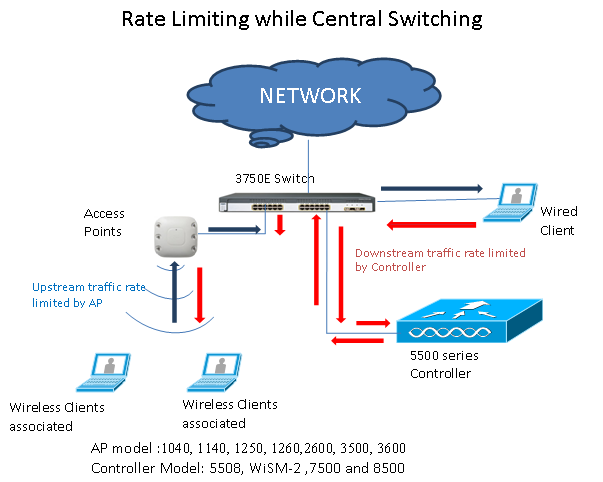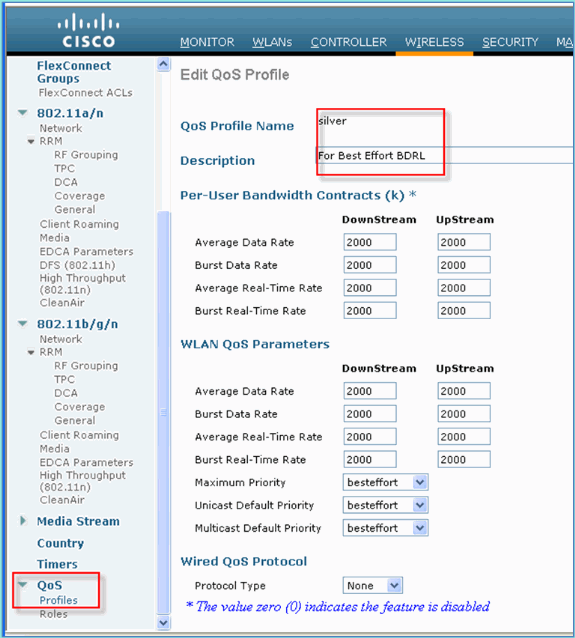- Cisco Community
- Technology and Support
- Wireless - Mobility
- Wireless - Mobility Knowledge Base
- Bi-Directional Rate Limiting (BDRL) - Release 7.3
- Subscribe to RSS Feed
- Mark as New
- Mark as Read
- Bookmark
- Subscribe
- Printer Friendly Page
- Report Inappropriate Content
- Subscribe to RSS Feed
- Mark as New
- Mark as Read
- Bookmark
- Subscribe
- Printer Friendly Page
- Report Inappropriate Content
09-28-2012 01:10 AM - edited 11-18-2020 03:00 AM
- Bi-Directional Rate Limiting (BDRL) – An Overview
- Detailed Information
- WLC configuration for Bi-directional Rate Limiting – Central Switching
- Advantages of BDRL
- Supported Access Points
- Supported Wireless Controllers
- Reference
Bi-Directional Rate Limiting (BDRL) – An Overview
Prior to WLC 7.2 releases, there is an ability to limit the downstream throughput across an SSID and per user on the Global interface.
With BDRL feature in the 7.3 release, rate limits can be defined on both upstream and downstream traffic, as well as on a per WLAN basis. These rate limits are individually configured. The rate limits can be configured on WLAN directly instead of QoS profiles, which will override profile values. The WLAN rate Limiting will always supersede Global QoS setting for WLAN and User.
In centrally switched WLANs, the downstream traffic is rate limited by the controller and the upstream is rate limited by the APs.
In local switched WLANs, both upstream and downstream are traffic are rate limited by the APs.
Detailed Information
This section describes BDRL of the 7.3 release. In releases 7.2 and earlier, there is only the ability to limit the downstream throughput across an SSID and per user on the Global interface. With this new feature in the 7.3 release, rate limits can be defined on both upstream and downstream traffic, as well as on a per WLAN basis. These rate limits are individually configured. The rate limits can be configured on WLAN directly instead of QoS profiles, which will override profile values.
This new feature adds the ability to define throughput limits for users on their wireless networks with a higher granularity. This ability allows setting a priority service to a particular set of clients. A potential use case for this is in hotspot situations (coffee shops, airports, etc) where a company can offer a free low-throughput service to everyone, and charge users for a high-throughput service.
Note: The enforcement of the rate limits are done on both the controller and AP.
- Rate limiting is supported for APs in Local and FlexConnect mode (both Central and Local switching).
- When the controller is connected and central switching is used the controller will handle the downstream enforcement of per-client rate limit only.
- The AP will always handle the enforcement of the upstream traffic and per-SSID rate limit for downstream traffic.
- For the locally switched environment, both upstream and downstream rate limits will be enforced on the AP. The enforcement on the AP will take place in the dot11 driver. This is where the current classification exists.
- In both directions, per-client rate limit is applied/checked first and per-SSID rate limit is applied/checked second.
- The WLAN rate limiting will always supercede the Global QoS setting for WLAN and user.
- Rate limiting only works for TCP and UDP traffic. Other types of traffic (IPSec, GRE, ICMP, CAPWAP, etc) cannot be limited.
- Only policing is implemented in the 7.3 releases.
- No coloring or traffic shaping is done in phase 1.
In releases before 7.3, there is an option to select the downstream rate limit thought the QoS profile page. In the 7.3 release this capability is expanded, which gives users that already make use of QoS profiles functionality additional granularity and capabilities. The trade off with configuring the rate limits under the QoS profile is that there are only four QoS profiles available. Thus, there are only four sets of configuration options to use.
Also, because the QoS profile is applied to all clients on the associated SSID, all clients connected to the same SSID will have the same rate limited parameters.
WLC configuration for Bi-directional Rate Limiting – Central Switching
This section provides a sample topology, basic Switch Integration, for BDRL in Central Switching Mode configuration.


Advantages of BDRL
This new feature adds the ability to define throughput limits for users on their wireless networks with a higher granularity. This ability allows setting a priority service to a particular set of clients. A potential use case for this is in hotspot situations (shopping malls, airports, etc) where a company can offer a free low-throughput service to everyone, and charge users for a high-throughput service.
Supported Access Points
This feature is supported on AP1140, AP1040, AP2600, AP3500, AP3600, AP1250, and AP1260.
All legacy AP platforms (1130, 1240 etc) and mesh platforms (1520, 1550) will not support this feature.
Supported Wireless Controllers
The following controllers support Rate Limiting:
- 5508
- WiSM-2
- 7500
- 8500
Reference
- Mark as Read
- Mark as New
- Bookmark
- Permalink
- Report Inappropriate Content
Hi,
Is BDRL supported on 702W APs?
Thanks,
Nick
- Mark as Read
- Mark as New
- Bookmark
- Permalink
- Report Inappropriate Content
Hi All,
I need to fully understand the workings of BDRL as I'm still unsure of the effect it will have on my traffic levels.
When BDRL is applied to an SSID the documentation says it is applied by the AP.
So if the rate limit is 1MB, does that mean each AP limits traffic on that SSID to 1MB? i.e. if there are 50 APs, does that mean that the total traffic on the whole SSID would be 50MB?
Or is there some mechanism taking place that limits the total traffic on the whole SSID to 1MB?
Any advice would be greatly appreciated.
John
Find answers to your questions by entering keywords or phrases in the Search bar above. New here? Use these resources to familiarize yourself with the community: